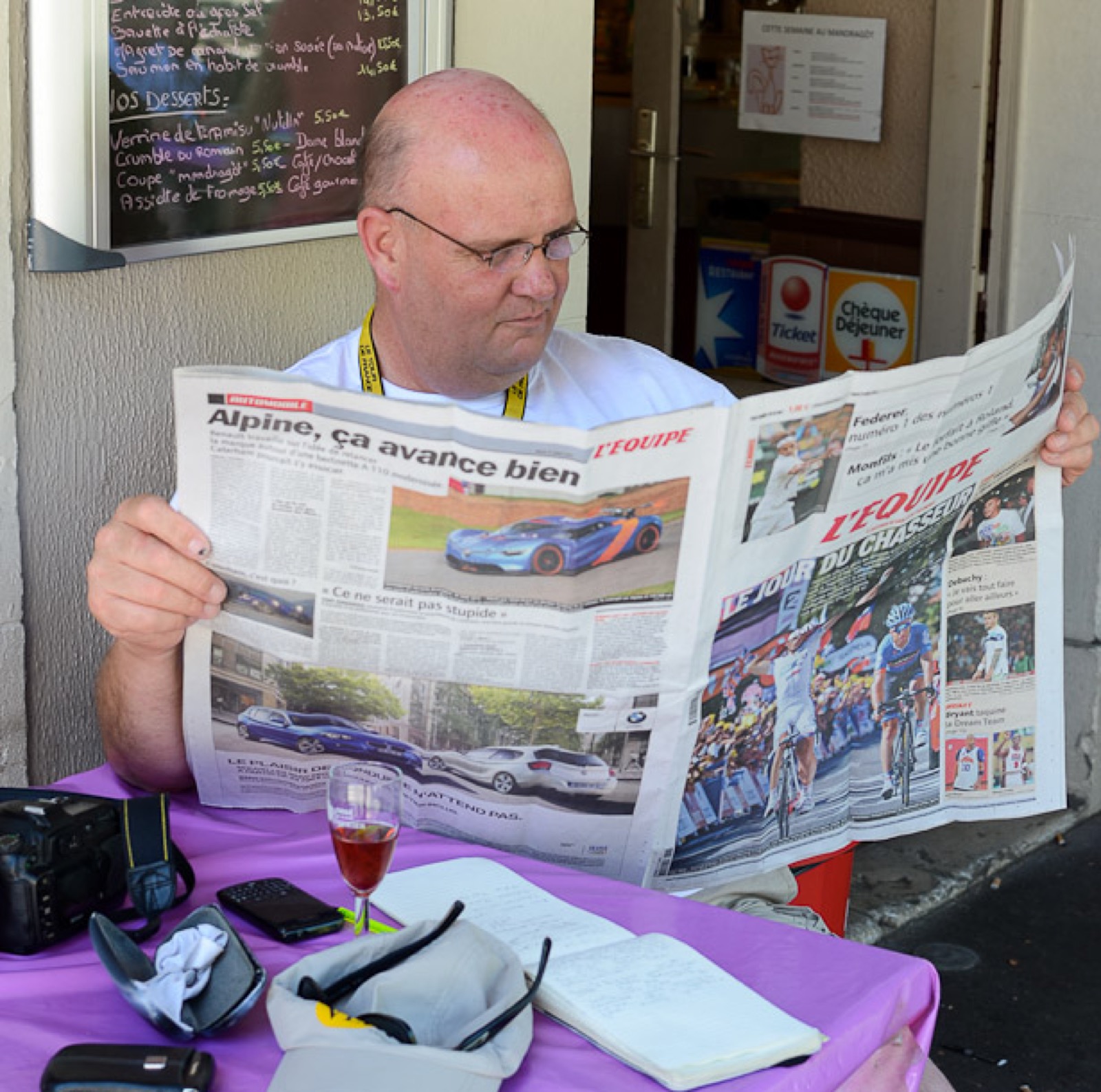An Introduction to Six Day Racing… Six Day races; they’re all fixed, aren’t they?
Yeah, for sure… all you have to do is take a lap from Bruno Risi and Franco Marvulli when they are at 97.5 % instead of ‘full-gas’. That’s maybe 57 kph instead of 58. Easy!

That’ll be how then-reigning World Champions, Bob Hayles and Mark Cavendish, were 34 laps down at Ghent last year: because it’s so “easy”.
The truth is that the Sixes are ‘choreographed’, but if you don’t have the legs, you can’t win.
Back in the 80’s, a certain German rider who had once been a ‘golden boy’, was riding his last Six.
He went to Australian Danny Clark, who was the ‘Daddy’ back then, and offered him big cash to be allowed to go out at the top. Clark said ‘No’, and the German upped his offer. Clark pointed out to him that he hadn’t finished on the podium all year and the public weren’t stupid, money didn’t come into it, he wasn’t going well enough to be allowed to win.
That said, if it’s the last chase at Copenhagen and home-boys Jakob Piil and Jimmi Madsen are going well, is it better for everyone if they win, rather than two Swiss guys, or worse — two Dutch guys? As the Americans say; ‘go figure!’ Choreographed or not, try and get tickets for the final couple of nights of a Six — it’s not easy, the crowds continue to flood-in despite what some cycling magazines might tell you.
The Races
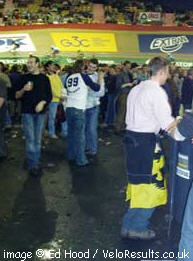
There are 13 Sixes this winter, starting with Maastricht at the end of September and ending with Hasselt (near Brussels) in mid-February by way of Amsterdam, Dortmund/Grenoble (these two are concurrent), Munich, Ghent, Zurich, Rotterdam, Bremen, Stuttgart, Berlin and Copenhagen.
This season will be the 96th running of Berlin, that’s hard to argue with and the crowds there are simply awesome with maybe thirty bars and restaurants to keep them fed and watered.
Many of theses are social as well as sporting occasions and indeed at Grenoble the cycling is just part of a huge cabaret with singers, dancers, acrobats and muscle-men acts.
Pictured is a party in Ghent last year. Even the floor was drunk.
The Format
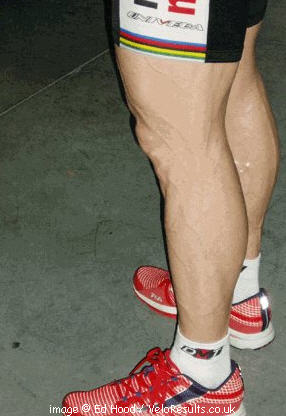
The UCI rules say that a “Six Day race shall last Six consecutive days with at least 24 hours’ racing time”. ‘Six Days’ is a bit of a misnomer, races are now conducted over six evenings with some having afternoon sessions.
Days which have two sessions are hugely unpopular with the riders and back-up staff, this is reflected in flat, uninspired racing during the daylight hours, often in front of very sparse audiences anyway.
The essence of Six Day racing is the madison (or chase) where laps are gained or lost as teams of two relay each other in and out of the maelstrom.
Madisons tend to last 45, 50 or 60 minutes and are fast and furious; although Copenhagen clings-on to the 90 minute chase these are generally an anti-climax because the riders are all so frightened of cracking.
Most sessions finish with a chase; If teams finish on the same lap then the outcome is decided on points. These are awarded for the other races which make-up the programme; derny-paced, sprint series, devils, points races and time trials.
The time trials are a very good indicator of who has good legs; stop watches can’t be arranged — distances are one lap, 500 metres and one kilometre, all from a flying start.
A recent innovation on the points-front is that every time a team garners 100 points they are awarded a bonus lap. This makes points all the more important and adds to the urgency in the supporting races as the finale approaches.
The Hardware
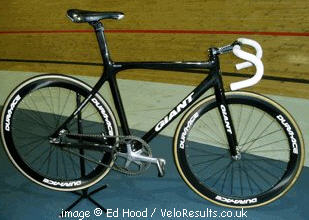
Wonder-material, carbon has been slower to march across the boards than it has the roads of Europe. Many six day riders are not part of big teams and have to pay for their equipment, so the costeffective, “made in Taiwan” over-size aluminium with carbon forks is the most popular choice.
Carbon is in evidence, Flying Dutchmen, Bob Slippens and Danny Stam ride matching, gem-like black carbon Giants but the Taiwanese company is one of their sponsors. Charismatic, handsome Swiss (I have to say that — I work for him) Franco Marvulli and countryman Alexander Aeschbach ride carbon Walsers; hand-made in small quantities in Switzerland, very aero and rigid.
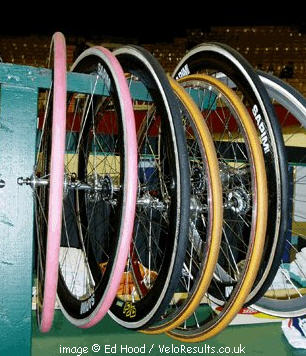
The traditional Six Day wheel from my youth in the 70’s has all but disappeared. Back then everyone rode Campag 36/36 large flange; chrome spokes tied and soldered on sprint rims with welded-joins — riveted-join rims weren’t used due to the possibility of the constant battering from the bankings causing failures.
Composite is king now, the Mavic five spoke is coveted but at around 2.000 euros each theses are generally on loan from federations. Xentis are a new name but popular on the boards because they are aero, light and cost-effective.
Rubber is usually from Continental although Scwalbes are becoming popular because of their competitive prices and those lucky Orangemen, Slippens and Stam number Dugaste amongst their sponsors.
Dugaste hand-make the best track and cyclo-cross tubulars in the world; instantly recognisable by their pink treads. They weigh-in at 150 euros each and last the same number of kilometres; so that’s two euros every kilometre you ride [or four for the team!] Campag and Shimano Dura Ace cranks are the transmission choice with a wide range of pedals on display — but all clipless now. Handlebars are square and shallow with Ahead universal. Saddles are in marked contrast to the other shiny kit on show, comfort is everything — a saddle sore can end your career and make you very ill so there are plenty battered old Rolls on display.
The Hard men
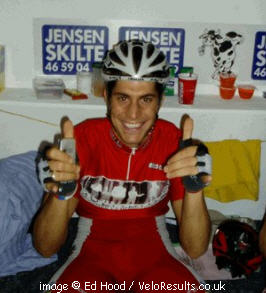
The most successful Six Day man ever is Patrick Sercu of Belgium with 88 wins off 223 starts.
The man with the most starts in Danny Clark (Australia) with 236, of which he managed to win 74.
Stats for current riders are obviously a bit of a moving target because there are races taking place all the time but the man with the most wins at the moment is Bruno Risi (Switzerland) who I make on 39; he’s also the mainman — nothing happens without Bruno’s say-so.
He lost a large chunk of last season through a bad crash but is back with a vengeance this year. Word from Maastricht (which he won with Marvulli) and Amsterdam is that he is flying.
Most starts belong to Gerd Dorich (Germany) who has ridden close to 150 events with just one win.
Risi and his countryman and brother-in-law Kurt Betschart have been the number one team on the circuit for almost a decade, but Betschart decided to call it a day last summer and it looks like Franco and Bruno will be become an item.
Top team last winter in Bruno’s absence were those Dutchmen with the nice kit I mentioned earlier — Slippens and Stam but Slippens crashed badly in the summer so Stam has been paired with countryman and world points champion Peter Schep.
Schep hasn’t been a ‘head’ on the circuit but the way he won the world championship in March was very impressive and this looks like a dangerous pairing.
Another of the top-men whose season has been compromised by a road crash is Matt Gilmore (Belgium), last season he and fellow-Belgian Iljo Keisse took three wins, including a memorable win at Ghent in front of an adoring home crowd.
VeloVeritas at the Sixes
We’ll be at the Grenoble Six Day trying to take you inside the closed little world of the ‘race to nowhere’ and hopefully serving-up some top interviews with the stars. We’ll also be at several early in 2007 – keep watching the Diaries section!


